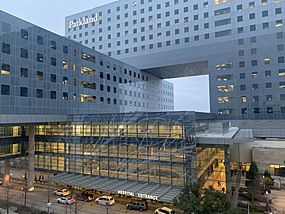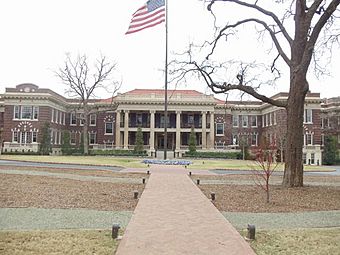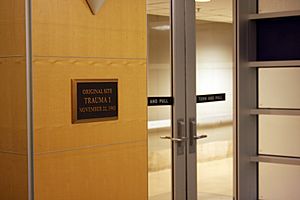Parkland Memorial Hospital facts for kids
Quick facts for kids Parkland Memorial Hospital |
|
|---|---|
| Parkland Health & Hospital System | |
 |
|

Parkland Memorial new hospital building dedicated in 2015.
|
|
| Geography | |
| Location | 5200 Harry Hines Boulevard, Dallas, Texas, United States |
| Coordinates | 32°48′37″N 96°50′20″W / 32.81028°N 96.83889°W |
| Organization | |
| Care system | Public |
| Hospital type | General assist and Intern teaching |
| Affiliated university | UT Southwestern Medical Center |
| Services | |
| Emergency department | Level I trauma center |
| Helipad | Yes |
| Beds | over 983 |
| History | |
| Founded | May 19, 1894 |
Parkland Memorial Hospital is a large public hospital in Dallas, Texas. It is the main hospital for the Parkland Health & Hospital System. It serves as the public hospital for Dallas County. The hospital is located in the Southwestern Medical District. Many doctors, residents, and medical students from UT Southwestern Medical Center work there. Parkland has been in three different locations since it started in 1894. The current hospital opened in 2015.
Contents
Hospital History
First Hospital Building (1894-1974)
|
Parkland Hospital
|
|

Parkland Hospital (1913-1954)
|
|
| Location | 3819 Maple Ave., Dallas, Texas |
|---|---|
| Area | 3.3 acres (1.3 ha) |
| Built | 1913 |
| Built by | G. W. Sonnefield |
| Architect | Hubbell & Greene |
| Architectural style | Colonial Revival, Georgian Revival |
| NRHP reference No. | 10000249 |
| Significant dates | |
| Added to NRHP | October 25, 2011 |
The first Parkland Hospital opened on May 19, 1894. It was in a wooden building on a 17-acre meadow. The hospital got its name because it was built on land originally bought by the city as a park. A brick building replaced the wooden one in 1913. This was the first brick hospital building in Texas. All services at this location stopped in 1974.
Second Hospital Building (1954-2022)
In 1954, Parkland Hospital moved to 5201 Harry Hines Boulevard. This new location was about a mile from the first one. Important new units opened here. A kidney dialysis unit opened in 1955. A special burns unit started in 1961. The cardiac intensive care unit began in 1969. The hospital expanded with new towers in 1981. A new wing at the entrance opened in the late 1980s. This second hospital building closed on July 11, 2022. It was taken down in 2024.
A Famous Day in History
Parkland Hospital is well-known because of events related to the assassination of President John F. Kennedy. President Kennedy, his assassin Lee Harvey Oswald, and Jack Ruby (who shot Oswald) were all brought to Parkland.
On November 22, 1963, President Kennedy was rushed to Parkland after being shot. He was pronounced dead at 1:00 p.m. in Trauma Room 1. This was 30 minutes after he was shot at Dealey Plaza. Texas Governor John Connally was also hurt in the shooting. He was treated in Trauma Room 2 and survived.
Two days later, on November 24, Oswald was brought to Parkland. He had been shot by Jack Ruby. Oswald died in operating room #5 after surgery. Ruby himself died at Parkland on January 3, 1967. He died in the same emergency department from a blood clot linked to lung cancer.
Since 1967, the areas where these events happened have been changed. A plaque marked the spot where Trauma Room 1 used to be. This area later became part of the hospital's radiology department. The ambulance entrance stayed in about the same place. Trauma Room 1 was taken apart in 1973. All its materials and equipment were kept by the government. Parkland's connection to JFK is remembered on a wall in the new hospital. It is also noted at the John F. Kennedy Park for Hope, Healing and Heroes memorial on campus.
New Hospital Building (2015-Present)
Parkland Hospital serves many patients. Because of this, the Dallas County leaders decided to build a new hospital. The old building was over 50 years old and too crowded. The new hospital is 17 stories tall and has 862 beds. It also has a large outpatient center and an office building. There is parking for 6,000 cars.
The total cost was $1.27 billion. This money came from three sources. Voters approved $747 million in bonds in 2008. The hospital used $350 million from its own money. Also, $150 million came from private donations. Companies like HDR, Inc. and Corgan helped design the new building. Many private donations were made. For example, the Bank of America Charitable Foundation gave $1 million. Donors' names are etched in glass panels in the main lobby.
A special feature of the new hospital is how people move around. Staff and supplies use separate hallways and elevators. This keeps them apart from patients and visitors.
Construction began in October 2010. The new hospital was officially opened in March 2015. All patients and staff moved into the new building in August 2015. On August 20, 2015, Parkland opened its new emergency department. It started accepting patients that day. The first baby born in the new hospital was a boy, delivered by Caesarean section that same morning.
The new hospital is right across Harry Hines Boulevard from the old one. It is easy to reach by public transport. The Trinity Railway Express and DART light rail both have stations nearby.
Awards and Recognition
Parkland has received many awards for its excellent work.
- Technology Use: The American Hospital Association has called Parkland one of the nation's "Most Wired™ Hospitals." This means Parkland uses technology well to help patients. It received this award from 2014 to 2017 and again in 2020.
- Stroke Care: In 2017, Parkland received the Gold Seal of Approval® from The Joint Commission. It also got the Heart-Check mark from the American Heart Association/American Stroke Association. These awards are for its excellent care for stroke patients.
- Fairness in Healthcare: In 2017, Parkland Health & Hospital System was named a Top Performer in LGBT Healthcare Equality. This award came from the Human Rights Campaign (HRC) Foundation. It shows Parkland's dedication to fair and welcoming care for all patients and their families.
- Green Campus: Parkland's main campus is the largest ENERGY STAR® certified healthcare campus in the U.S. It has over 3.1 million square feet of space with this certification. The campus also has six buildings that are LEED Gold certified. These buildings use recycled water, solar energy, and native plants. Parkland is also a top user of renewable energy in Texas healthcare. This earned it recognition from the Environmental Protection Agency.
- Sustainable Healthcare: In 2024, Parkland received The Joint Commission’s Sustainable Healthcare Certification. This shows its commitment to being environmentally friendly and reducing carbon.
Hospital Leadership
In May 2017, Dr. Fred Cerise, who is the president and CEO of Parkland Health & Hospital System, was chosen for an important role. The U.S. Comptroller General appointed him to the Medicaid and CHIP Payment and Access Commission (MACPAC). As a member, Dr. Cerise advises Congress on issues about Medicaid and the CHIP.
Trauma Care and Training
Parkland's Rees-Jones Trauma Center is very important. In 2016, its staff started teaching classes to the community. These classes teach people how to stop serious bleeding. This training helps people give medical aid before professional rescuers arrive. These "Stop the Bleed" classes are part of a big U.S. Government effort. The goal is to make this training as common as CPR.
The staff of Parkland's Emergency Department and Trauma Center received an award in 2016. They got the Texas Preparedness Leadership Award for their amazing work during the 2016 Dallas Police Shootings.
What Parkland Hospital Does
Parkland is the public hospital for Dallas County. It gets most of its money from a special property tax on Dallas County residents.
Parkland is one of Dallas's five Level I Trauma Centers. This means it can handle the most serious injuries. It is also a main care center for Dallas County residents. Along with UT Southwestern, it is a major hospital for medical and surgical referrals in North Texas and parts of Southern Oklahoma. This means many different medical and surgical experts work there. This also makes Parkland a great place for doctors to get advanced training.
The Parkland Burn Center is one of the largest civilian burn units in the U.S. It is famous for the Parkland Formula. This formula helps doctors give the right amount of fluids to burn patients. It was one of the first treatments for burns that included rehydration and managing electrolytes.
Parkland is one of the largest teaching hospitals in the country. Texas Woman's University started its nursing program at Parkland in 1954. It is still close to the campus. Parkland is also the main teaching hospital for the nearby University of Texas Southwestern Medical Center.
Parkland delivers more babies than almost any other hospital in the nation. It averages 15,000 to 16,000 deliveries each year. That's more than 42 babies every day! Parkland has eleven prenatal clinics. It employs 72 doctors training to be obstetricians-gynecologists and 45 nurse-midwives. Parkland also created one of the first high-risk pregnancy units. It had the first neonatal intensive care unit (NICU) in North Texas.
Parkland's emergency department has about 240,000 visits each year. This includes the main emergency department and an urgent care unit.
Parkland is also the base for Biotel. This is the medical direction system used by Dallas Fire-Rescue. It is also used by fourteen other emergency medical service groups in the Metroplex.
Hatcher Station Health Center
In May 2014, construction began on a new Parkland-affiliated clinic. This clinic is near Fair Park. It is a 44,300-square-foot outpatient center. The clinic, called Hatcher Station Health Center, opened on May 19, 2015.
It serves older patients and those needing mental health care. It also helps adults, women, children, and babies. The clinic offers X-rays and lab services. Its exam rooms have flexible equipment. There is also a conference room for health education programs.
See also
 In Spanish: Hospital Memorial Parkland para niños
In Spanish: Hospital Memorial Parkland para niños
- List of hospitals in Texas
- National Register of Historic Places listings in Dallas County, Texas
- List of Dallas Landmarks
- John Peter Smith Hospital




